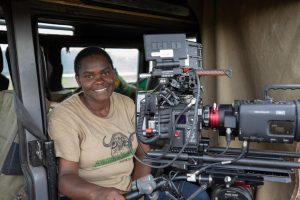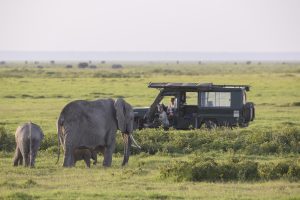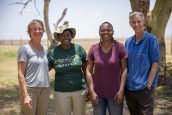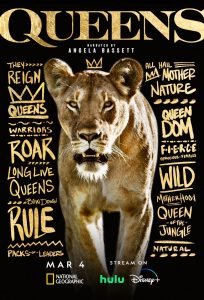
QUEENS Mentee and Filmmaker Erica Rugabandana | ©2024 National Geographic for Disney / Millie Marsden
QUEENS, on National Geographic and Disney+, is a seven-episode documentary series spotlighting matriarchal animal groups, made by a group of primarily women filmmakers. Different segments focus on wildlife in the savannahs, in Africa, in the rainforest, in the coasts and oceans, and in the mountains, as well as on insects and aunts. The series is narrated by Angela Bassett, one of its executive producers. The first three episodes premiered on Monday, March 4; the remaining four will debut on Monday, March 11.
Sophie Darlington is, with Justine Evans, the series director of photography on QUEENS. Her previous credits include PBS NATURE, PENGUINS, OUR PLANET, and PLANET EARTH II.
Faith Musembi is director of the QUEENS episode “Savannah Queens” and producer/director of “Behind the Queens.” She has directed, edited and produced on a number of television series, and, with QUEENS, is also the first Kenyan woman to be a major part of a wildlife documentary shot in that country.
During National Geographic’s portion of the Winter 2024 Television Critics Association (TCA) press tour, Darlington and Musembi talk about their work on QUEENS.
Darlington begins the discussion. “We got involved in the project through the fact that, as a cinematographer, when I started out, there was less than on one hand of us [women documentarians], and when we decided we were going to make this, it’s very much a woman-led project. We welcome all the help we’ve had from the men there, too, as our allies, but there were only a couple of us that [executive producer] Vanessa [Berlowitz] could have chosen to have been directors of photography, because there are so few. But the whole idea was that we would get more in the field, and more people who didn’t look like what wildlife traditionally looks like. And that is Faith.”
Musembi elaborates, “I’m a Kenyan, from Kenya, and one of the episodes in QUEENS was filmed in Kenya. There were so many things that aligned, because traditionally, the way natural history films are made, locals aren’t involved. But the ambition of QUEENS was to involve more local filmmakers. My [background] is in documentaries. So, anything but this kind of content. And at the time, the team’s ambition was to work with local filmmakers, to do something different, to raise up women filmmakers, because it didn’t happen in the industry. It was very competitive, to be a part of the project. I was interviewed, and actually, Sophie was one of the people who interviewed me.”
“Can I say, we snapped her up,” Darlington enthuses, “because she’s such a talent. Faith and I worked together very closely. I was lucky enough to be one of Faith’s mentors, and I think she was one of mine as well.” The women share a laugh. “She started out as a field director, on the elephants, on ‘Savannah,’ which is one of QUEENS’s great eps, and then ended up being the producer/director for ‘Behind the Queens,’ which is the final episode of QUEENS.”
Of “Behind the Queens,” Musembi says, “It’s just this beautiful cocktail of shining a spotlight on the mentors, like Sophie and Justine, and then the people who are mentored, such as myself and a few of the other cinematographers. But also, platforming these incredible women[-led] conservation groups that helped us do what we did. Without them in the field, we probably wouldn’t have been able to have the access.”
“Putting a spotlight not only on the amazing leadership in nature,” Darlington adds, “and how females lead in nature, but also that goes behind the camera and throughout the whole production team. We just worked out that seven babies were born during the production. It’s just incredible.”
Darlington is referring to human infants, not the wildlife births documented in the series. “Our production team, seven of them had babies during, and carried on working the way they wanted to work. The whole way the production was made was to try and shake up the system. I stopped [working] for eight years when I had a child, because there was nothing one could do to be [allowed to work while pregnant or a new mother]. That didn’t happen on this project. It’s a groundbreaking series in so many ways.
Is it easier to do documentaries about humans, who may argue with the filmmakers, or about animals? Musembi and Darlington share another laugh.
“I’d say humans,” Darlington opines, “because you can tell them what to do. You try getting a lioness – ‘Could you do that again, please?’ There’s a big refusal. “What’s the saying, ‘You can bring a horse to water, you can’t make it drink’? Try that with an elephant.”

Cinematographer and mentee Erin Ranney films elephants on the RED Gemini and Canon CN20 in QUEENS | ©2024 National Geographic / Oscar Dewhurst
Musembi agrees. “And that’s the beauty of what we do. You can’t script the animals. And something I think is important to talk about – climate change is just wreaking havoc. Because with the natural world, there are all these patterns that we rely on, that our scientists and researchers who we work with rely on to predict the behavior we want to film. But then, what happens is, you go into the field, you’re expecting this to happen, but because of how the world is upside-down, because of everything that’s happening, the behavior doesn’t happen.”
Even so, Darlington notes, “We ended up with a series, and every single thing you see in that episode is real life. Nothing is CGI, nothing is fake, that is the animals doing their thing. And it’s hard to believe, when you see that jewel bee, and you go, ‘That can’t be real,’ it is all real. The technology that went into this series, making it, we’re all so incredibly proud, because I think it’s the best series I’ve ever worked on, full stop.”
What would Musembi and Darlington most like people to know about QUEENS? For Musembi, “I really love the qualities that are portrayed in the animal leaders, and just the resilience when they’re up against their own species, against humans. I really want people to take onboard those lessons, but also to see how the series was made, as not a blueprint of how we should roll forward, but as a presentation of the possibilities.”
“And,” Darlington concludes, “encourage people who look and see Faith producing/directing, see Erin [Ranney], or our [other] mentees, and go, ‘I could do that.’ That would be really exciting.”
Related: QUEENS: Cinematographers Justine Evans and Erin Ranney on their new National Geographic miniseries
Follow us on Twitter at ASSIGNMENT X
Like us on Facebook at ASSIGNMENT X
Article Source: Assignment X
Article: Exclusive interview with QUEENS Cinematographer Sophie Darlington and producer-director Faith Musembi on new documentary series
Related Posts:












